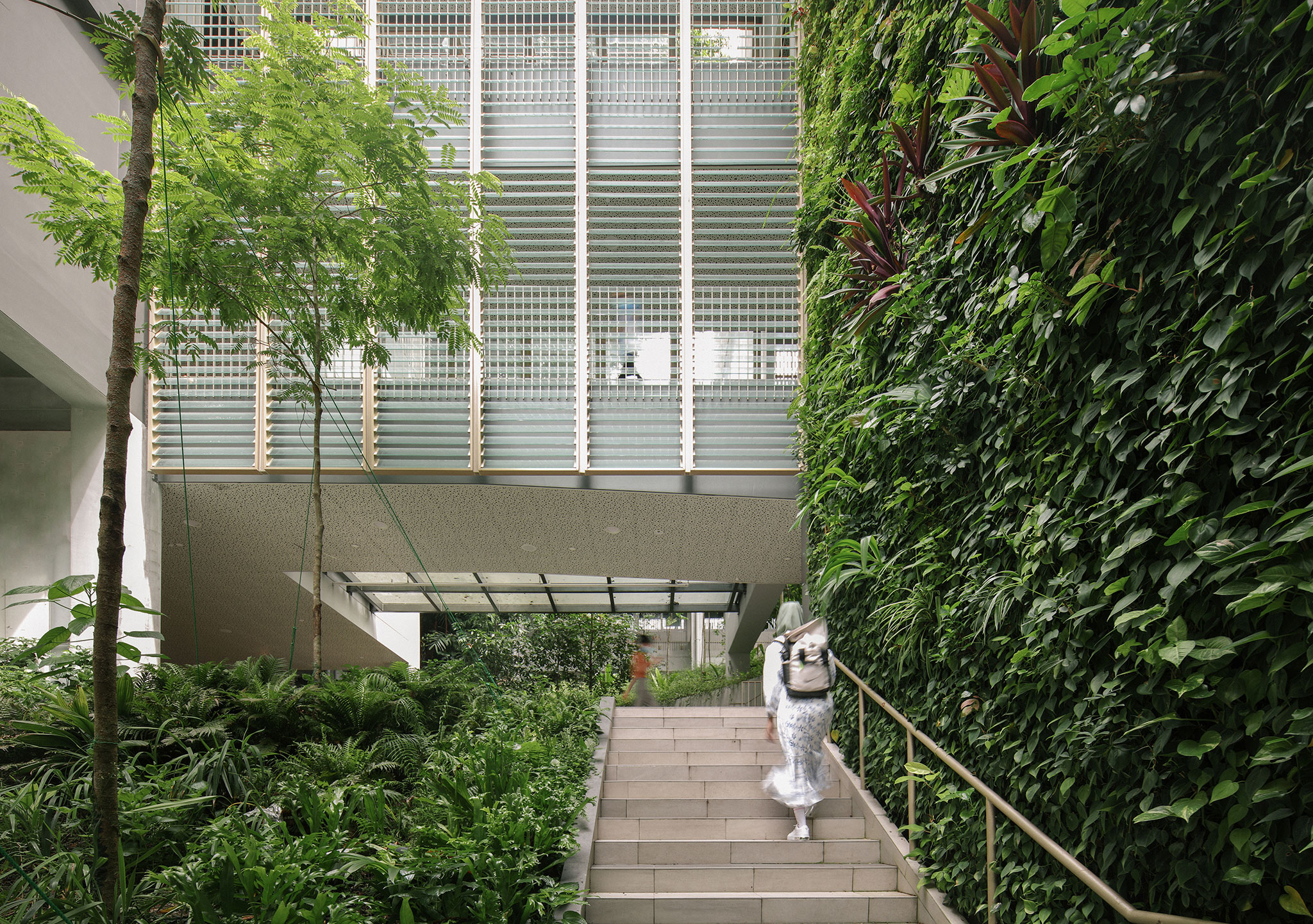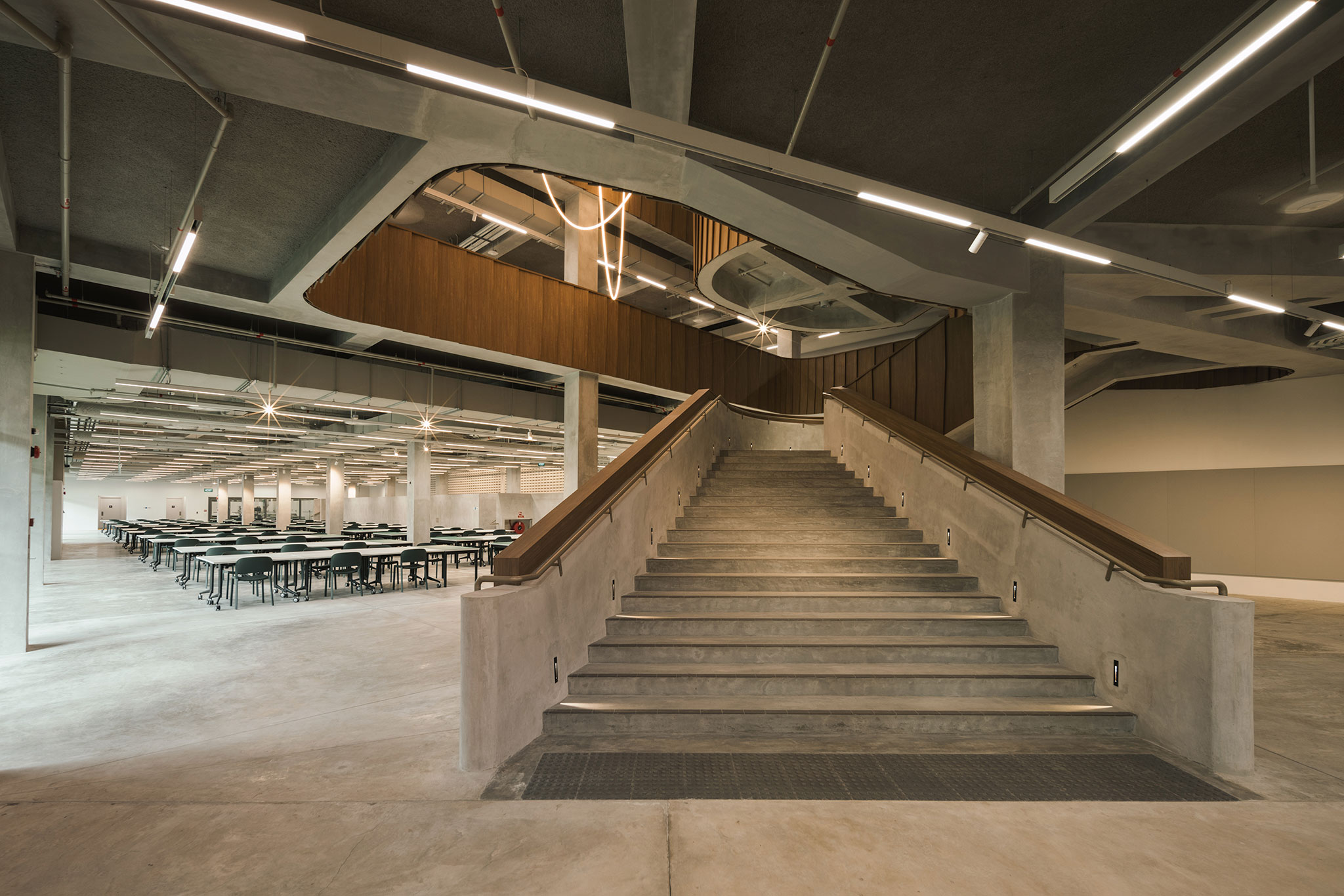The building integrates principles of vernacular architecture in Southeast Asia. The extended west façade is designed as an envelope that engages with the tropical climate. It screens the building from heat gain by creating a deep veil, an aesthetic expression combining formal design and performance capabilities.
There is deliberate integration between the built and natural environments with gradients of indoor, semi-outdoor, and outdoor spaces. The landscape design emulates the diverse functionality of local habitats and ecosystems with a selection of native species as part of research programs conducted by the faculty of landscape architecture. The central courtyard, previously concealed by built structures, is redesigned to encapsulate the tropical climate of Singapore with verdant landscape and jungle-like qualities. Departmental and faculty offices are distributed around this tropical patio, bringing the surrounding landscape into close proximity with interior spaces, therefore, enhancing its biophilic experience.

School of Design and Environment by Erik L’Heureux. Photograph by Finbarr Fallon.

School of Design and Environment by Erik L’Heureux. Photograph by Finbarr Fallon.
Project description by NUS College of Design and Engineering (CDE)
The College of Design and Engineering at the National University of Singapore is redefining sustainability leadership in Asia by championing environmental education, advocating for sustainable practices, and transforming its campus with design prototypes to positively influence the built environment across the tropics.
February 2023 marks the launch of NUS Cities, a global collaborative platform focused on urban sustainability to drive education, research, and advisory services in Asia primarily as well as the opening of SDE1 and 3 (School of Design and Environment 1 and 3), an inventive educational architecture developed by the College of Design and Engineering at the National University of Singapore (NUS) with an in-house core team of seasoned practitioners drawn from the Department of Architecture in collaboration with industry firms. Sited in SDE1 and 3, NUS Cities shall serve as a corporate leadership hub for learning and knowledge sharing across research and educational institutions in Singapore as well as internationally.
The opening of SDE1 and 3 as super-low carbon and net-zero energy adaptive reuse demonstrates an effective strategy for urban sustainability by optimizing the operational performance of built assets, showing a strong integration of design excellence and sustainability leadership. The building offered a unique opportunity to become a case study for the redevelopment of existing infrastructure and will significantly influence technological experimentation and architectural thinking in Singapore and the tropical region.
Located along Clementi Road near the southern coastline of Singapore, SDE1 and 3 is a new addition to the College of Design and Engineering precinct and it is part of a larger campus redevelopment for the 2030 net-zero carbon target. The climate-responsive building includes more than 23,000 square metres of design studio space, workshops and research centres, a 1000-square-metre open loggia, exhibition galleries, shared and faculty offices and a wide variety of public and social spaces. Combined with Singapore’s first new-build net-zero energy building SDE4, the new SDE1 and 3 development serve as a living lab to integrate NUS’s research to drive translational solutions, repurposing the University to be a resilient campus.

School of Design and Environment by Erik L’Heureux. Photograph by Finbarr Fallon.
Aaron Thean, Dean of the College of Design and Engineering, explained: “Sustainability will be an enabler of the solution. We strongly believe that the aspirations of the project can inspire, and increase awareness of technology, design quality, and sustainability in our graduates. SDE 1 and 3 represent the next benchmark for renovation and sustainable development for the built environment in the future."
Designed by the College of Design and Engineering with CPG Consultants through an academia-industry collaboration launched in 2015, the building was envisioned as a pedagogical tool for the design education of architects and future practitioners. Erik L’Heureux, Associate Professor and Design Lead, described that “the SDE1 and 3 development rethink the value of adaptive reuse projects by investing in the agency of architecture to create beautiful and highly performative buildings. Everything is visible, it's open, and it's accessible for students and faculty to learn from and to teach from. The transformation of SDE 1 and 3 offers an encapsulation of the future of architectural education in Singapore; an ethos of subtracting rather than adding, conserving rather than demolishing, of relying on natural ventilation rather than air conditioning, and creating design quality rather than prioritizing on real estate quantity.”
The building integrates principles of vernacular tropical architecture in Southeast Asia, leading design innovation in an era of rapid advancement in architecture, sustainability, and building technology. The extended west façade is designed as an equatorial envelope that engages with the tropical climate. It screens the building from heat gain by creating a deep veil, an aesthetic expression combining formal design and performance capabilities while establishing a visual resonance with neighbouring buildings. Its structure integrates light shelves to drive daylight into the studio spaces through clerestory windows positioned along an inner window wall.
The design utilizes its existing carbon form from the original 1976 structural frame to position its own architecture as an opportunity for design experimentation oriented towards crafting sustainable architecture calibrated to the equatorial climate and the urban and natural systems that it is situated within. Giovanni Cossu, Associate Director of Sustainability Services at the National University of Singapore, explained: “This project has given us an opportunity to develop design prototypes in a tropical climate to achieve cost efficiency, high environmental and sustainability performance coupled with design quality. It strongly builds on the concept of decarbonization, carbon longevity and durability to remain functional as it transitions from old to new over time, expanding on the university’s Environmental, Social, and Governance (ESG) agenda."
Air-conditioning is used only when needed while the building’s total energy consumption is projected to be one-third of pre-renovation levels. More than 65% of the total area is hybrid-cooled with tempered air or naturally ventilated, while most of the rooms can be opened to prevailing breezes. With a low embodied carbon footprint, estimated to be lower than a third of similar new construction, and predicted net positive energy performance, SDE 1 is on track to be net-zero carbon over its lifecycle.

School of Design and Environment by Erik L’Heureux. Photograph by Finbarr Fallon.
Architecture is pedagogically founded on the importance of a public forum for exhibition and architectural debate with blurred boundaries between places to study, work and socialize. Erik L’Heureux, Associate Professor and Design Lead, highlighted that “three-floor plates of design studios are linked by a large staircase that serves as a social centre, encouraging interpersonal dialogue. The staircase’s proximity to review spaces and an exhibition gallery publicizes student drawings and models to the community of the architecture program around the unique learning experiences of public reviews.” Each studio space is tied to a conjoined maker’s and exhibition space so that display, debate, reviews, design, and fabrication could occur in public view across the length of the building.
There is deliberate integration between the built and natural environments with gradients of indoor, semi-outdoor, and outdoor spaces. The landscape design emulates the diverse functionality of local habitats and ecosystems with the selection of native species as part of research programs conducted by the faculty of landscape architecture. The central courtyard, previously concealed by built structures, is redesigned to encapsulate the tropical climate of Singapore with verdant landscape and jungle-like qualities. Departmental and faculty offices are distributed around this tropical patio, bringing the surrounding landscape into close proximity with interior spaces, therefore, enhancing its biophilic experience. SDE1 and 3 are likely to be one of the earliest developments in Singapore to achieve WELL certification for adaptive reuse, demonstrating that the quality of healthy building design can also be achieved in renovation projects.
Supporting a country's environmental effort with Singapore’s Green Plan 2030, the university embraced larger national ambitions and adopted net-zero energy as an essential goal for its campus. SDE1 and 3 are designed to be climate responsive with low carbon and net-zero energy consumption featuring a range of innovative technologies and more than 2000 solar photovoltaic panels on its rooftop. Air quality is improved by digital controls as well as deploying a hybrid cooling system, a transformation of the approach deployed at the net-zero-energy SDE 4 building, designed by Transsolar KlimaEngineering and IEN Consultants that supplies rooms with 100% fresh pre-cooled air, albeit at higher temperatures and humidity levels, and augmented with an elevated air speed by ceiling fans. In doing so, the design leverages the performative need for air volume for comfort while simultaneously expanding the experience of the building section.
Nirmal Kishnani, Associate Professor at the National University of Singapore, explained: ‘It is no longer sufficient to talk about 30, 40, 50% energy efficiency. It is not enough to talk about platinum buildings. Now the conversation has moved on to net-zero or carbon-neutral thinking. And I believe that the NUS projects are very much part of that shifting conversation. I would like to think that the buildings developed at the College of Design and Engineering have actually paved the way for policy, making policymakers more confident that it can be done in a way that is cost-effective."
































































































